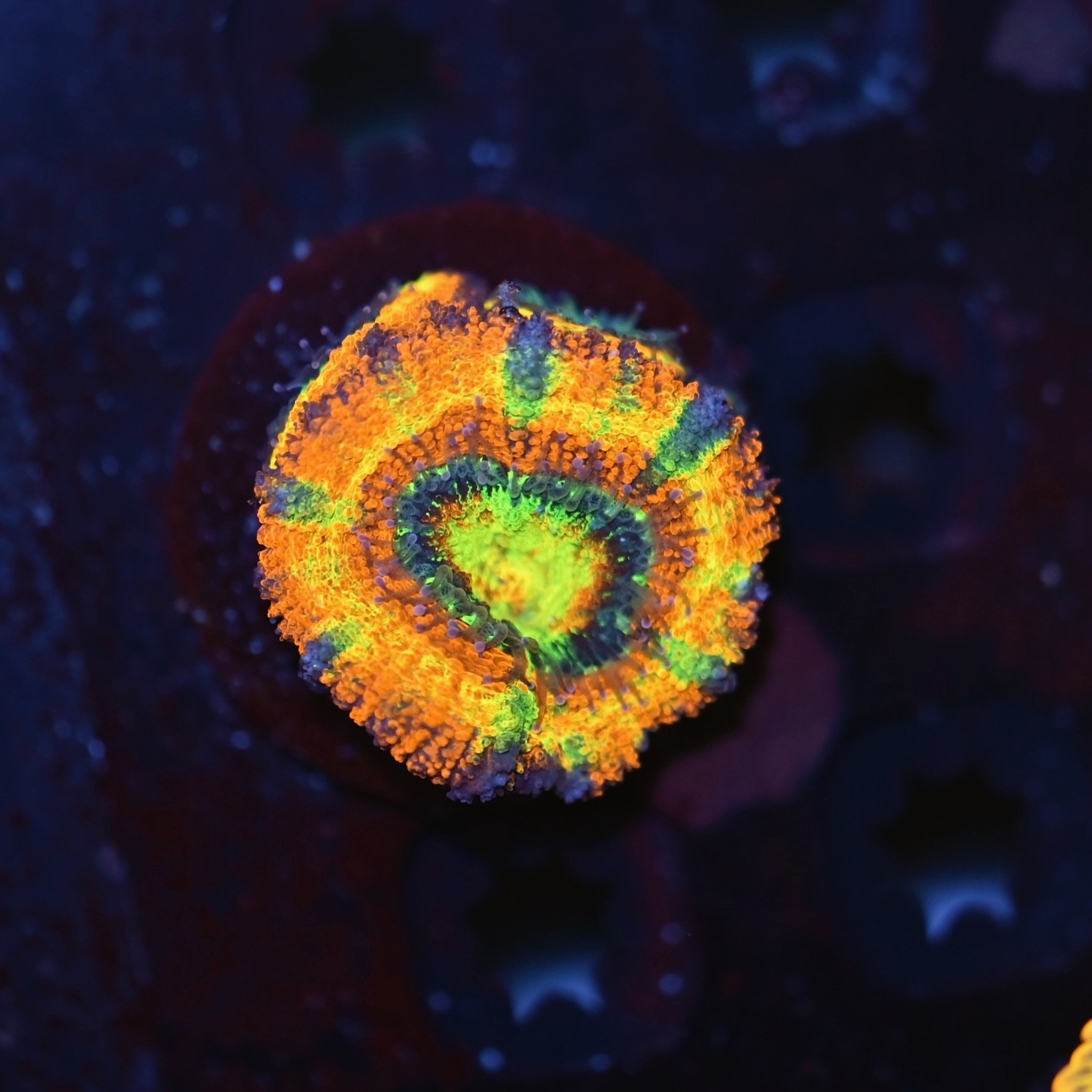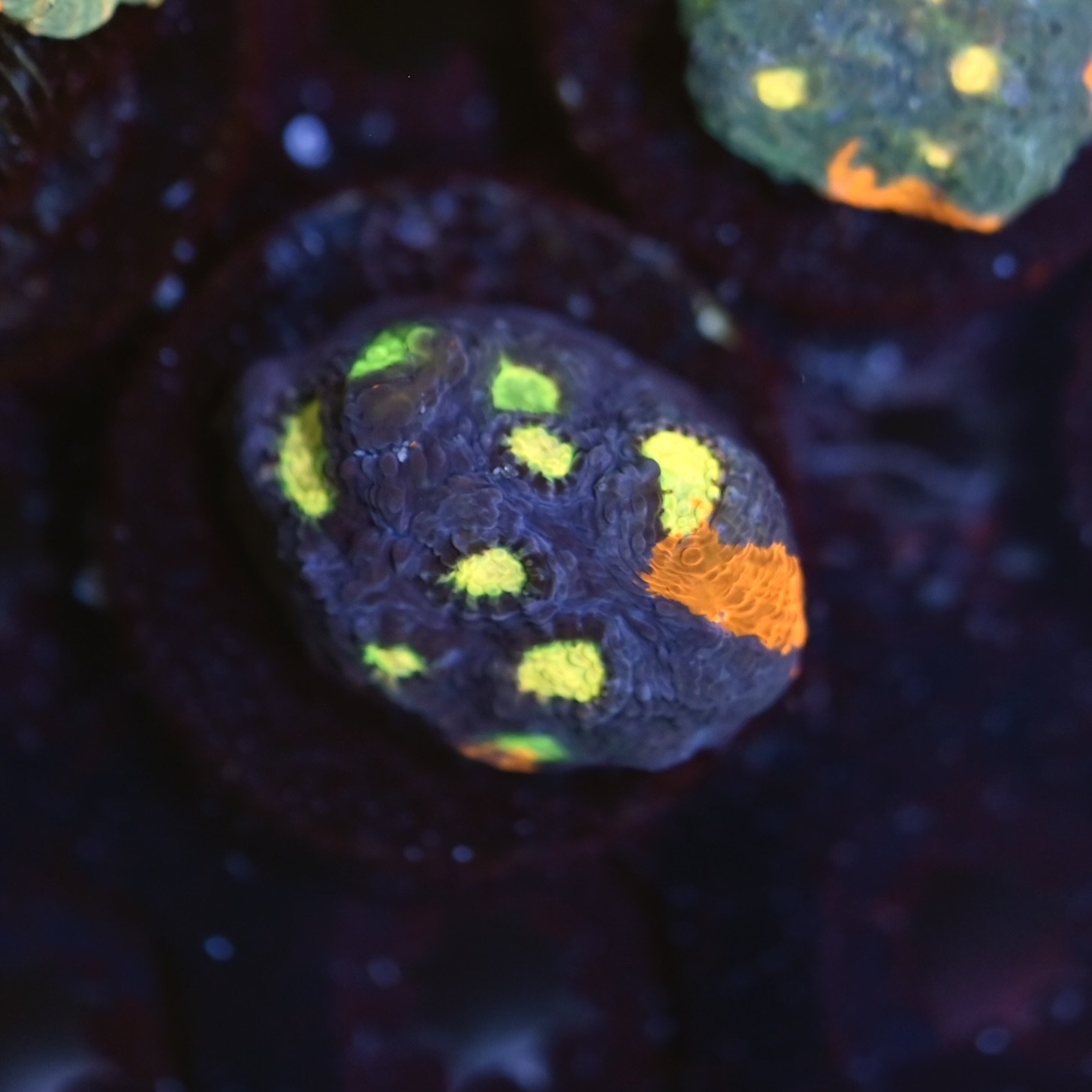 Image 1 of 2
Image 1 of 2

 Image 2 of 2
Image 2 of 2



Rainbow Acan
Lighting:
Low to moderate light preferred.
PAR range: 50–120.
High light can bleach or dull colors — acclimate slowly if increasing.
Under blue-spectrum lighting, their colors pop most vividly.
Flow:
Low to moderate, indirect flow.
Too much flow can cause polyps to retract or tissue to tear.
Gentle, random flow keeps detritus off without stressing the coral.
Water Parameters:
Temp: 76–80°F (24.5–26.5°C)
Salinity: 1.025
pH: 8.1–8.4
Alkalinity: 8–10 dKH
Calcium: 400–450 ppm
Magnesium: 1250–1350 ppm
Nitrates: 1–10 ppm
Phosphates: 0.01–0.05 ppm
Stability is more important than chasing numbers — avoid rapid parameter swings.
Feeding:
Very receptive to feeding, and feeding enhances growth and coloration.
Target feed 2–3x per week (especially at night or when tentacles are visible).
They can puff up dramatically when eating — a fun coral to watch during feeding!
Placement:
Bottom to mid-level of tank.
Flat rock surfaces or sand bed are ideal.
Ensure polyps don’t get shaded or blasted with flow.
Aggression:
Mild to moderate.
Doesn’t usually send out long sweepers, but may sting nearby tissue if crowded.
Keep 2–3 inches between acans and other LPS corals.
Fragging:
Easy to frag with a bone cutter, dremel, or band saw.
Cut between polyps, not through them.
Heals relatively quickly with good flow and stable conditions.
Common Issues:
Tissue recession or melting: Often caused by alkalinity swings, poor water quality, or pest irritation.
Aiptasia or vermetid snails: Check regularly.
Color fading: May indicate too much light or nutrient starvation.
Lighting:
Low to moderate light preferred.
PAR range: 50–120.
High light can bleach or dull colors — acclimate slowly if increasing.
Under blue-spectrum lighting, their colors pop most vividly.
Flow:
Low to moderate, indirect flow.
Too much flow can cause polyps to retract or tissue to tear.
Gentle, random flow keeps detritus off without stressing the coral.
Water Parameters:
Temp: 76–80°F (24.5–26.5°C)
Salinity: 1.025
pH: 8.1–8.4
Alkalinity: 8–10 dKH
Calcium: 400–450 ppm
Magnesium: 1250–1350 ppm
Nitrates: 1–10 ppm
Phosphates: 0.01–0.05 ppm
Stability is more important than chasing numbers — avoid rapid parameter swings.
Feeding:
Very receptive to feeding, and feeding enhances growth and coloration.
Target feed 2–3x per week (especially at night or when tentacles are visible).
They can puff up dramatically when eating — a fun coral to watch during feeding!
Placement:
Bottom to mid-level of tank.
Flat rock surfaces or sand bed are ideal.
Ensure polyps don’t get shaded or blasted with flow.
Aggression:
Mild to moderate.
Doesn’t usually send out long sweepers, but may sting nearby tissue if crowded.
Keep 2–3 inches between acans and other LPS corals.
Fragging:
Easy to frag with a bone cutter, dremel, or band saw.
Cut between polyps, not through them.
Heals relatively quickly with good flow and stable conditions.
Common Issues:
Tissue recession or melting: Often caused by alkalinity swings, poor water quality, or pest irritation.
Aiptasia or vermetid snails: Check regularly.
Color fading: May indicate too much light or nutrient starvation.
































